ILIGAN CITY (MindaNews / 06 September) – Before entering the gates of the Toril compound in Barangay Ubaldo Laya in Iligan City, an evacuation center for Maranao families displaced by the Marawi siege that started on May 23, one can already hear children’s laughter and chatter. Once inside, one can see to the left an abandoned three storey building with big windows, some covered with colorful batik, and others framing faces of people peering outside, watching the day by below. Inside the building, batik cloths act as substitute for walls that form boxes where the displaced families live.
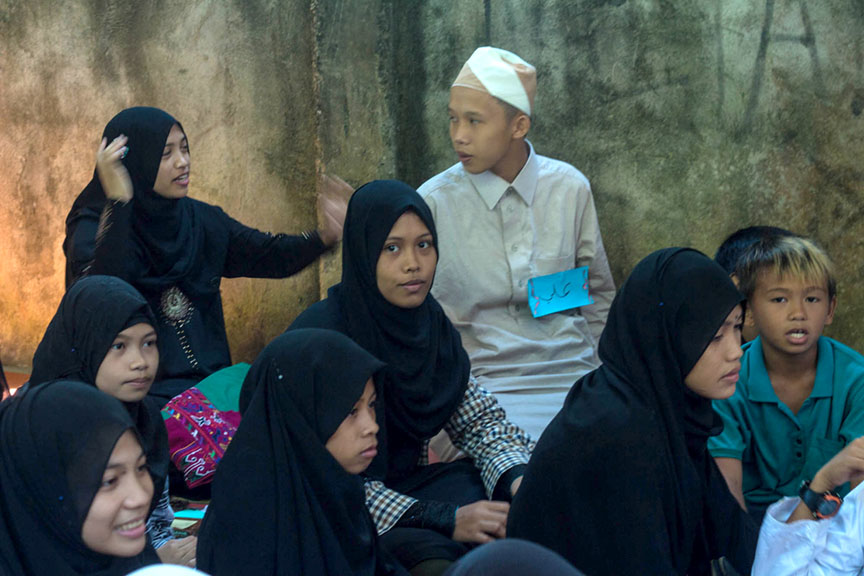 Madrasah students enjoy each other’s company as their ustadz divide them into different firqa or teams for the games and recitation and declamation activities organized in the weekend after Eid’l Adha at the Toril evacuation center in Iligan City. MindaNews photo by JEAN CLAIRE DY
Madrasah students enjoy each other’s company as their ustadz divide them into different firqa or teams for the games and recitation and declamation activities organized in the weekend after Eid’l Adha at the Toril evacuation center in Iligan City. MindaNews photo by JEAN CLAIRE DY
Outside, there is a clothesline at the far end of the compound, a makeshift kitchen at the back with a small gas stove and some pots. On the corner are two big blue water drums donated by Medecins Sans Frontieres. The rest of the compound is a wide lawn with a basketball court where one will see the children whose laughter and chatter usually pervade the entire place and spill beyond the gates.
About a hundred children evacuees are staying indefinitely in this compound, some as young as three months old. But on the grounds, one would meet children ranging from 10 to 16 years old.
The days go by slowly for them, but they make do with what they have with toys made out of garter, sticks, and a rundown wheelbarrow left by the owners of this compound that was supposed to be a boarding school.
The adults find ways to survive the long days, some try to find work outside but to no avail as work in Iligan City is scarce. With the help of a local female Maranao principal who acts as caretaker of the compound, two women have set up shop: one operates a sari sari store by the entrance to the building and another recently put up as small carinderia near the gate.
It is a slow life here in the Toril compound, painfully slow as some evacuees say. A life disrupted by war can be slow, a sharp contrast to how fast their lives have changed when the conflict started.
“It happened so fast that we didn’t even have the chance to bring other important documents. We escaped with just the clothes that we were wearing that day,” Yusoph Bara-amal said. “I just made sure my family will be safe.”
Yusoph, a carpenter from Barangay Mapandi in Marawi City, has four children, the youngest born in a hospital six days after the start of the siege.
For Farhana, Yusoph’s wife, the drastic change in their fate is sometimes unbearable. She worries about her children and how they will be able to live a normal life. One of them, she said, experienced nightmares during the first month in the evacuation center. According to her, the boy would wake up in the middle of the night and would take his younger sibling, and start running out of the building screaming “we have to go, we have to escape, they will kill us.”
The Bara-amal family is just one among 260 families occupying the compound. Most of them fled Barangay Mapandi and other areas near the fighting. Each family has about four to nine children dealing with the traumas of war for the past three months.
Madrasah as Space for Psychosocial Intervention
Somewhere to the right corner of the Toril compound is a small madrasah standing unobtrusively, built with slabs of wood and some galvanized sheets of iron two weeks ago with the help of a few donors. Inside, there is an intricately designed rug that covers its cement floor where students are supposed to sit facing one blackboard. On its façade are tarpaulins that carry anti-terrorism slogans, and a campaign to stop the war in Marawi and support peace. A place for children to learn Islam, the madrasah in Toril is quaint and unassuming. The children are allowed to study for free and classes are held every Saturday and Sunday.
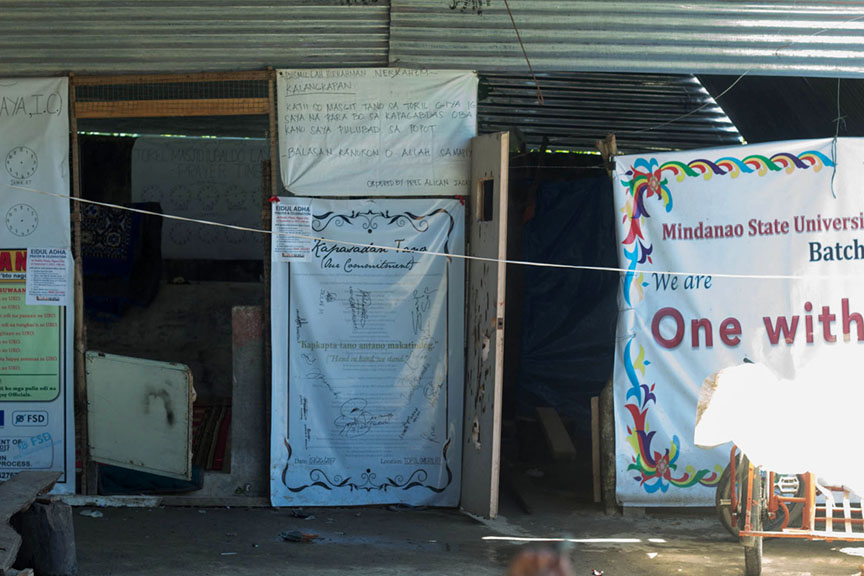 The new madrasah in Toril evacuation center has been around for only two weeks but students are pouring in because they don’t have to pay for enrollment. Children evacuees have something to do on the weekends, which according to psychosocial volunteers is a good thing because their days will be full. MindaNews photo by JEAN CLAIRE DY
The new madrasah in Toril evacuation center has been around for only two weeks but students are pouring in because they don’t have to pay for enrollment. Children evacuees have something to do on the weekends, which according to psychosocial volunteers is a good thing because their days will be full. MindaNews photo by JEAN CLAIRE DY
Esnaira Ismail, a 10-year old girl who one often finds loping around the compound, expressed her happiness over the presence of the madrasah. “I like it because I can learn a lot about Islam and about how to become a good person. And there are games!” she said with a wide grin on her face. “But I also like going to the school nearby during the week because I have Christian friends there.”
The idea of building a madrasah in an evacuation center came about following news reports in July that displaced children in one evacuation center in Iligan City view the ISIS fighters, most of whom are members of the Maute group fighting government forces for control over Marawi City, as heroes. This observation was revealed after the Philippine Sports Commission held a play time with five sports psychologists and during the activity, boys revealed their dreams of becoming Maute fighters rather than athletes.
Mouhammad Camal Sharief, head of the Peace in Our Hearts organization, and a volunteer working with Ranaw Foundation and the Institute for Peace and Development in Mindanao (IPDM), said the reports are true. During his initial psychosocial encounters with the children, one boy when asked what he wanted to be when he grows up joked that he wanted to be a Maute fighter.
During the first month of their stay in Toril, one boy was seen waving a flag made out of a black shirt and a stick, and shouting “Allahuakbar!” There were also cases when kids were heard chanting “sundalo, pugot ulo!” (literally behead soldiers). Those times, the children thought they were just playing. According to Sharief, this was alarming but reckoned the children were still trying to make sense of what happened to them.
“When a child’s life is suddenly disrupted by conflict and he/she has to flee from the normalcy of his/her home, there is confusion, therefore part of psychosocial services is to sort of provide an anchor to the child’s life, to bring back a sense of normalcy,” Sharief explained.
For Sharief, one way to bring back that normalcy is to reclaim the symbolic spaces that children associate with their home. According to him, the two anchors that unite Maranaos are religion and culture, and these two are intertwined. One can see this in Marawi where madaris and masjids are ubiquitous. Every Maranao has studied in a madrasah.
Sharief himself knows the feeling of disruption caused by the Marawi Crisis because he is a “bakwit” (internally displaced person) himself. The only way he was able to cope with the loss of his home is to be a humanitarian volunteer for his people and not give in to treating himself as a victim. Through Peace in Our Hearts, Sharief realized “that the highest form of psychosocial intervention is through religion.”
This point of view is also being supported by the National Commission on Muslim Filipinos (NCMP) that is advocating for psychosocial intervention using the Islamic perspective. This was strengthened when news broke that some groups who were doing psychosocial intervention in the evacuation centers gave out Bibles and used the opportunity to preach the Christian religion.
“We appreciate relief being given to us, but we appreciate it if help is culturally sensitive and not used to exploit our vulnerabilities in these trying times,” Sharief pointed out.
Countering Violent Extremism Through the Madrasah
However, one of the important hurdles that Maranaos also have to face is the evolving stereotype that the madaris, mosques, and other spaces where Islam is being practiced are breeding grounds for terrorists or violent extremists like the Maute fighters who have been linked to the ISIS.
In a recently published analysis on violent extremism in Marawi and beyond, Steven Rood of The Asia Foundation pointed out that “we ought not to target Islam as the cause of extremism” but we have to realize that vulnerable individuals who have lived in generational conflict are more susceptible to recruitment. Referencing French analyst Olivier Roy, Rood mentioned the “Islamization of radicalism” as one reason why the problem of extremism has metastasized.
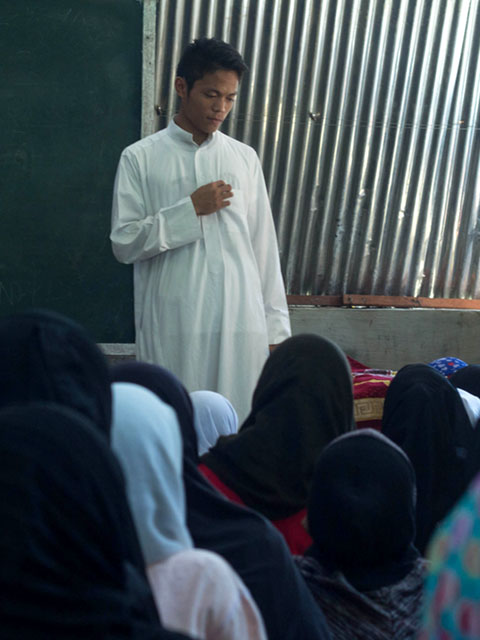 Ustadz Farhad talks to students inside the new madrasah in the Toril evacuation center in Iligan City before the start of the contest on the art of the musabaqah. MindaNews photo by JEAN CLAIRE DY
Ustadz Farhad talks to students inside the new madrasah in the Toril evacuation center in Iligan City before the start of the contest on the art of the musabaqah. MindaNews photo by JEAN CLAIRE DY
“This means that those influenced by generational revolt or opposition to dominant societal paradigms are more likely to generate narratives from their understanding of Islam… Now the Islamic State has provided a compelling vision of a worldwide caliphate as a possible ideology,” Rood wrote.
Through the madrasah project, Sharief and his co-volunteers from Peace in Our Hearts want to espouse a more moderate view of Islam. Knowing that a 2015 survey conducted showed that 90% of the communities in the Autonomous Region in Muslim Mindanao point to the Muslim religious leaders as the most influential, Peace in Our Hearts decided to select young ustadz who teach moderate views of Islam, and who also emphasize that Islam is a religion of peace.
Sharief observed that because the Maranaos have lost their sense of communality, the youth are susceptible to being influenced by more fundamentalist views of Islam. “This project is to counter the violent extremism. The most important thing being taught here is the akhlaq, which is like GMRC (good manners and right conduct) or character building, then rules on prayers and making ablution,” Sharief said. In almost all activities in the curriculum for the madrasah, Sharief included psychosocial and peace advocacy.
Teaching Culture as a Form of Moral Recovery
On the weekend after the celebration of Eidl Adha, Peace in Our Hearts with IPDM, organized a two-day event for the students of the madrasah.
Last Saturday, the children gathered in the basketball court under the scorching heat of the sun. The group is composed of mostly female students wearing hijabs and waving their colorful flags that represented the four different firqas or teams they belonged to witness the art of the musabaqah.
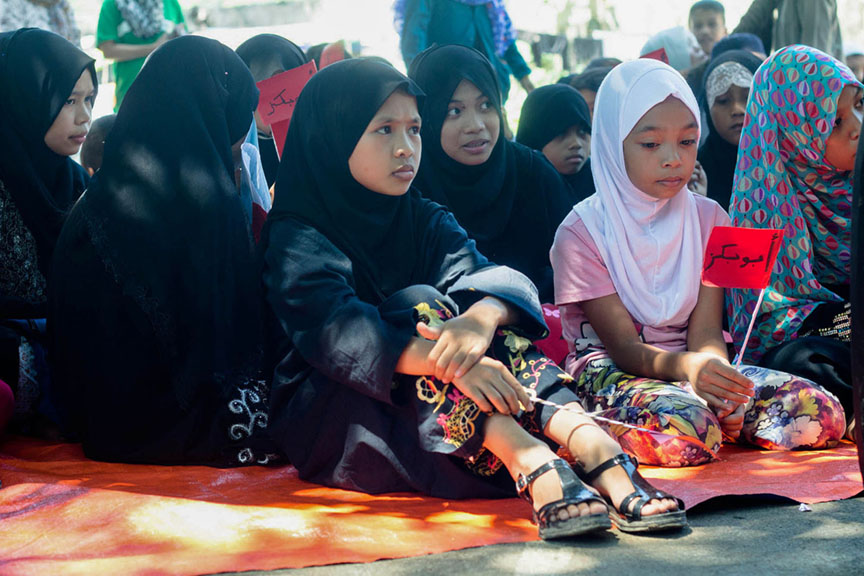 Children listen to the ustadz explaining the rules of the recitation contest. MindaNews photo by JEAN CLAIRE DY
Children listen to the ustadz explaining the rules of the recitation contest. MindaNews photo by JEAN CLAIRE DY
That day, the Toril compound was filled with chanting as contestants tried their best to recite Quran verses from memory. There were occasional microphone glitches, and the speaker stopped working at some point. But fixing the sound system became a communal effort. Men were able to find tapes to patch the microphone wires. There was a sense of excitement in the air even among the parents watching the contest.
When it was 16-year old Farouq Mobin’s turn to recite the verses came, some students were teary eyed because they were recently told that Farouq is one of the few who will be returning to the Mindanao State University main campus in Marawi to continue his studies. The university has already opened its doors to students who insisted to continue their education even as from the hill where MSU stands, one can see smoke coming from the ongoing airstrikes. When asked how she felt about Farouq’s recitation, 10-year old Raihana Abdul Azis expressed that he was good but some of the children in the compound said they will miss him. Others felt a little sad that they aren’t able to return to their homes as well.
The madrasah curriculum doesn’t only focus on religion but also Maranao culture. “Most importantly we include the cultural awareness in a form of moral recovery,” Sharief said. According to him, there are so many communal aspects of Maranao culture that are slowly fading away. Bringing this back is one form of fighting extremism as well.
This is why they included Maranao traditional games the day after. On Sunday, there were games that boys joined where they hop like frogs to win a race. There was also a contest of who among the firqa is the fastest to piece together one Torogan 3D Architecture Puzzle donated by the creators of Balay Balay 3D Architecture Puzzles in Davao City.
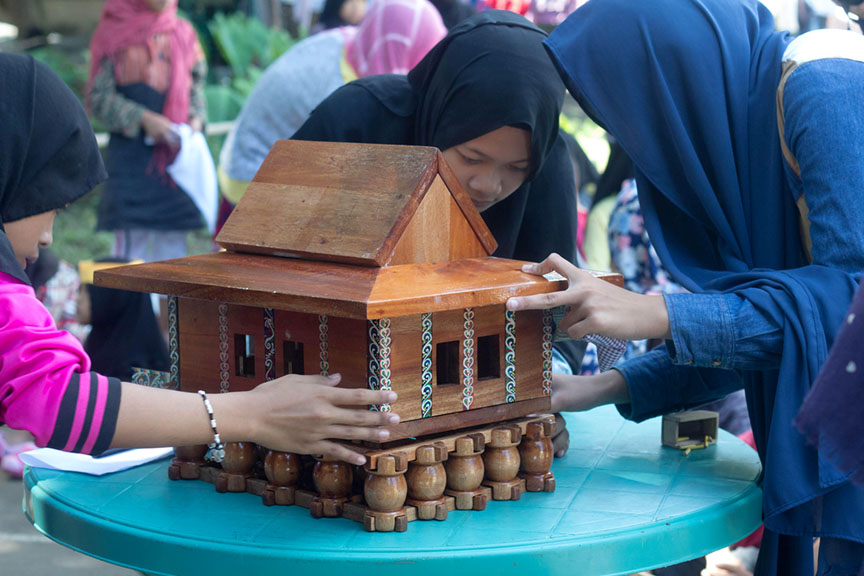 PIECING A HOUSE. Female students of the newly built madrasah in the Toril compound, a home-based evacuation center in Iligan City that houses families displaced by the Marawi crisis, try to piece together the Torogan 3D Architecture Puzzle.
PIECING A HOUSE. Female students of the newly built madrasah in the Toril compound, a home-based evacuation center in Iligan City that houses families displaced by the Marawi crisis, try to piece together the Torogan 3D Architecture Puzzle.
Other students look on in amazement when the house was formed. The puzzle solving activity was part of the two-event organized by Peace in Our Hearts, Ranaw Foundation, and the Institute of Peace and Development in Mindanao as part of their psychosocial services given to the children traumatized by the battle in Marawi. MindaNews photo by JEAN CLAIRE DY
According to Nihaya Panimbang, a volunteer with Peace in Our Hearts, and an AB History major from MSU-Iligan Institute of Technology here, the Torogan is an example of traditional Maranao architecture that is representative of Maranao cultural heritage. “The Torogan is Maranao. It is Marawi. You can only see the Torogan there. When people see it, they remember Marawi, “she said. Nihaya showed the children how to piece together the Torogan puzzle before they could try to do it themselves.
Nihaya wanted to do her thesis on the Torogan but she was told by her teacher that it is difficult because the original Torogan house can only be found in Marawi. At the moment, it is hard to have access to the city and her safety is of utmost importance. Nihaya believes in preserving the cultural heritage of Maranaos represented by the Torogan. She reveals that one important aspect of the Torogan is that it is a communal space used for conflict mediation, a process that is much needed in these times.
“Torogan, torogan, Marawi, Marawi”
Once some boys saw the puzzle being formed into a Torogan with all its okir glory, they started shouting “Torogan, torogan, Marawi, Marawi!” For Nihaya, it was a beautiful and yet heartbreaking sight to witness. “But I am happy they were able to play with it because it is part of remembering who they are, their cultural heritage as Maranaos, despite the war. We as the youth have a responsibility to preserve that.”
This madrasah is an important project for the Maranao volunteers and also the evacuees in the Toril compound. Three months have gone by, the conflict in Marawi continues, and the evacuees in Toril compound still wait for an ending, hoping that they may be able to go back to their homes soon despite that they know their houses are in rubble.
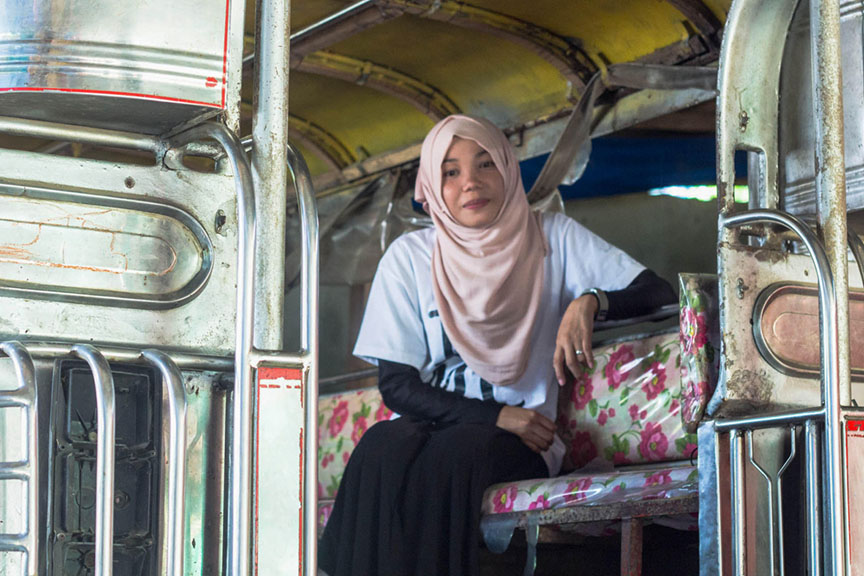 Strong women are the hope of the new generation. Nihaya Panimbang is a Maranao student taking up AB History in MSU-IIT who is volunteering for Peace in Our Hearts implementing projects in the evacuation centers in Iligan City. She wanted to do her thesis on the Torogan, the traditional architectural house of the Maranaos, but she was told she will have a hard time because the original Torogan house can only be found in Marawi. Nihaya believes in preserving the cultural heritage of the Maranaos represented by the Torogan. MindaNews photo by JEAN CLAIRE DY
Strong women are the hope of the new generation. Nihaya Panimbang is a Maranao student taking up AB History in MSU-IIT who is volunteering for Peace in Our Hearts implementing projects in the evacuation centers in Iligan City. She wanted to do her thesis on the Torogan, the traditional architectural house of the Maranaos, but she was told she will have a hard time because the original Torogan house can only be found in Marawi. Nihaya believes in preserving the cultural heritage of the Maranaos represented by the Torogan. MindaNews photo by JEAN CLAIRE DY
The rebuilding of Marawi as some of the evacuees say would be not as fast as piecing the Torogan puzzle together. But the dream is there. Yusoph for instance, is planning to go back to find out if his house is still intact. Being a carpenter, he is confident he will able to able to rebuild his home once the conflict has abated. “I will go back and bring my family if I am very sure it is already safe,” he said. “Meanwhile, they have to stay here. There are people here who are helping us. Their hearts are full. “
Walking around the Toril compound dressed in jeans, a printed T-shirt that says #IamMarawi, and wearing Converse sneakers, Sharief appears hopeful. The children and the young ustadz refer to him as kuya, sometimes laughing along with his jokes, sometimes talking to him about their dilemmas. After taking a puff from his cigarette, he points at the madrasah and emphasized its importance for the Maranaos who left Marawi because of the war.
His voice raising a notch higher, Sharief opines that “the victim of this war is really Islam and the Maranao culture. Since Maranaos are anchored on religion and culture we have to push through with this program and advocate that this will be replicated in other evacuation centers.”
(Jean Claire Dy is a writer, filmmaker, and educator. She is the founder of Stories Beyond www.stories-beyond.com, an organization that envisions to tell restorative narratives of communities, beyond the single story. She holds a Masters in Media Studies and Film from the New School University in New York, which she completed with a fellowship from the Ford Foundation International Fellowships Program.
